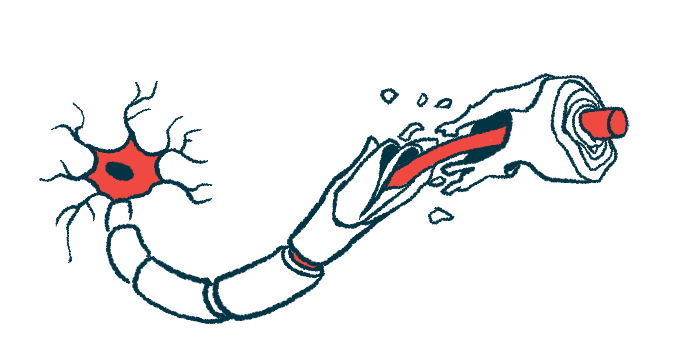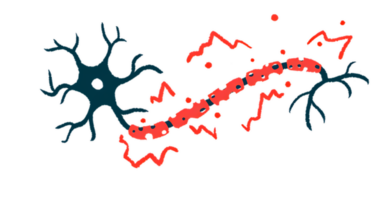XPro1595 may promote myelin restoration, new mouse study finds
Findings challenge hypothesis now in use for developing MS treatments

INmune Bio‘s experimental therapy XPro1595 may promote myelin restoration through the activation of two types of nervous system support cells, according to new data that may lead to novel treatment strategies for multiple sclerosis (MS) and other neurodegenerative disorders.
The findings highlight the activation of microglia, key immune cells in the central nervous system (CNS), and star-shaped cells called astrocytes.
Such a strategy is in contrast to the existing hypothesis that reduced activation of these cell types — collectively known as glial cells — is what’s needed to promote nervous system repair in diseases like MS.
“This finding supports our belief that immunosuppressive therapies that turn off the glial cells will not help repair and regeneration of the brain in neurologic diseases,” CJ Barnum, PhD, vice president of CNS drug development at INmune Bio, said in a company press release.
The data were presented in a pair of poster presentations at the 16th European Meeting on Glial Cells in Health and Disease, held in Berlin July 8-12.
XPro 1595 found to promote remyelination in mice
In MS, the immune system mistakenly attacks myelin, the fatty sheath that surrounds and protects nerve cells. As a consequence of myelin loss, or demyelination, nerve cells are vulnerable to damage, which ultimately leads to neurodegeneration.
“Demyelination is an important part of the pathology of many neurodegenerative diseases including multiple sclerosis (MS) and Alzheimer’s disease (AD),” said Lesley Probert, PhD, a professor at the Hellenic Pasteur Institute, in Greece.
Therapies to promote myelin restoration, or remyelination, are thus of significant interest for MS and other neurodegenerative diseases. However, none currently exist. In part, that may be due to the fact that the biology underlying this process is not well understood.
XPro1595, or simply XPro, is a molecule designed to selectively block a certain form of tumor necrosis factor (TNF), a pro-inflammatory molecule that is implicated in a number of autoimmune diseases.
Specifically, XPro blocks soluble TNF, a version of the protein that’s circulating in the body’s fluids. This protein is implicated in nervous system damage when it binds to its receptor protein, called TNFR1.
Its counterpart, transmembrane TNF, which is found at the surface of immune cells, can actually be beneficial to nervous system function when binding to its receptor, TNFR2. This molecule is not targeted by XPro, meaning that the repairing properties of TNF are still retained — unlike currently approved TNF inhibitors.
Data from a Phase 1 study (NCT03943264) involving Alzheimer’s patients indicated that the therapy might promote myelin repair.
In follow-up preclinical experiments, researchers found that XPro promoted remyelination in a mouse model in which myelin loss is induced by a chemical called cuprizone.
That remyelination appeared to be driven by the activation of microglia and astrocytes, which enabled clearance of damaged myelin and paved the way for more efficient repair.
When the mice were genetically engineered to lack TNFR1 specifically in microglia, the researchers observed similar remyelinating effects as when blocking or inhibiting soluble TNF with XPro.
With the recent experiments, the scientists aimed to learn more about how XPro1595 affects microglia and astrocytes to promote nervous system repair in the cuprizone model.
Results from XPro 1595 study ‘contrary to current dogma’
In a poster titled, “Therapeutic modulation of solTNF-TNFR1 signaling selectively in microglia promotes remyelination in the cortical grey matter” (abstract T16-155C), the researchers further explored the role of microglia — which serve as the resident immune cells of the nervous system — in this process.
The team found that, in addition to promoting remyelination, genetic removal of TNFR1 in microglia helped to restore more normal motor function in the mice.
Microglia in these mice showed signs of an altered activation state, indicating a switch toward a “pro-repair phenotype [profile] which favors remyelination,” the researchers wrote.
In turn, deleting the TNFR2 receptor from these cells prevented functional recovery in mice during the remyelination phase. According to the team, that indicates that transmembrane TNF and its receptor are essential for efficient myelin repair after damage.
In a second poster, titled “Distinct astrocyte activation profiles associated with demyelination in the cuprizone model of multiple sclerosis” (abstract T16-156C), the scientists looked more closely at the role of astrocytes, cells known for their star shape that work to support neuronal function.
Similarly to the microglia, the astrocytes showed signs of rapid activation in response to demyelination during XPro treatment. Moreover, genetic removal of TNFR1 specifically in astrocytes was able to recapitulate the remyelinating effects of XPro1595.
“This work shows that astrocytes, the most abundant cell in the brain after neurons, like microglia, are intimately involved in driving the neuroinflammation component in demyelinating diseases,” Probert said.
This work shows that microglia and astroglia must express biomarkers of activation to promote remyelination. This finding is contrary to current dogma that suggests decreased glial activation is required to promote remyelination.
The work also indicates that, in contrast to previous beliefs, increased activation of both of these cell types is needed for remyelination.
Activated microglia and astrocytes often are associated with a neuroinflammatory environment, and thus, it has generally been believed that a reduction in their activation is needed to promote nervous system repair.
“This work shows that microglia and astroglia must express biomarkers of activation to promote remyelination,” Barnum said, noting that “this finding is contrary to current dogma that suggests decreased glial activation is required to promote remyelination.”
The data will be expanded into a more detailed publication in the future, according to INmune Bio.








